Retail Purchasing and Supply Chain Management
VerifiedAdded on 2023/06/15
|10
|2941
|494
AI Summary
This essay focuses on the role of purchasing and supply in the Sainsbury super market. It discusses the primary components of the purchasing and supplying chains and analyses the implications of management as well.
Contribute Materials
Your contribution can guide someone’s learning journey. Share your
documents today.
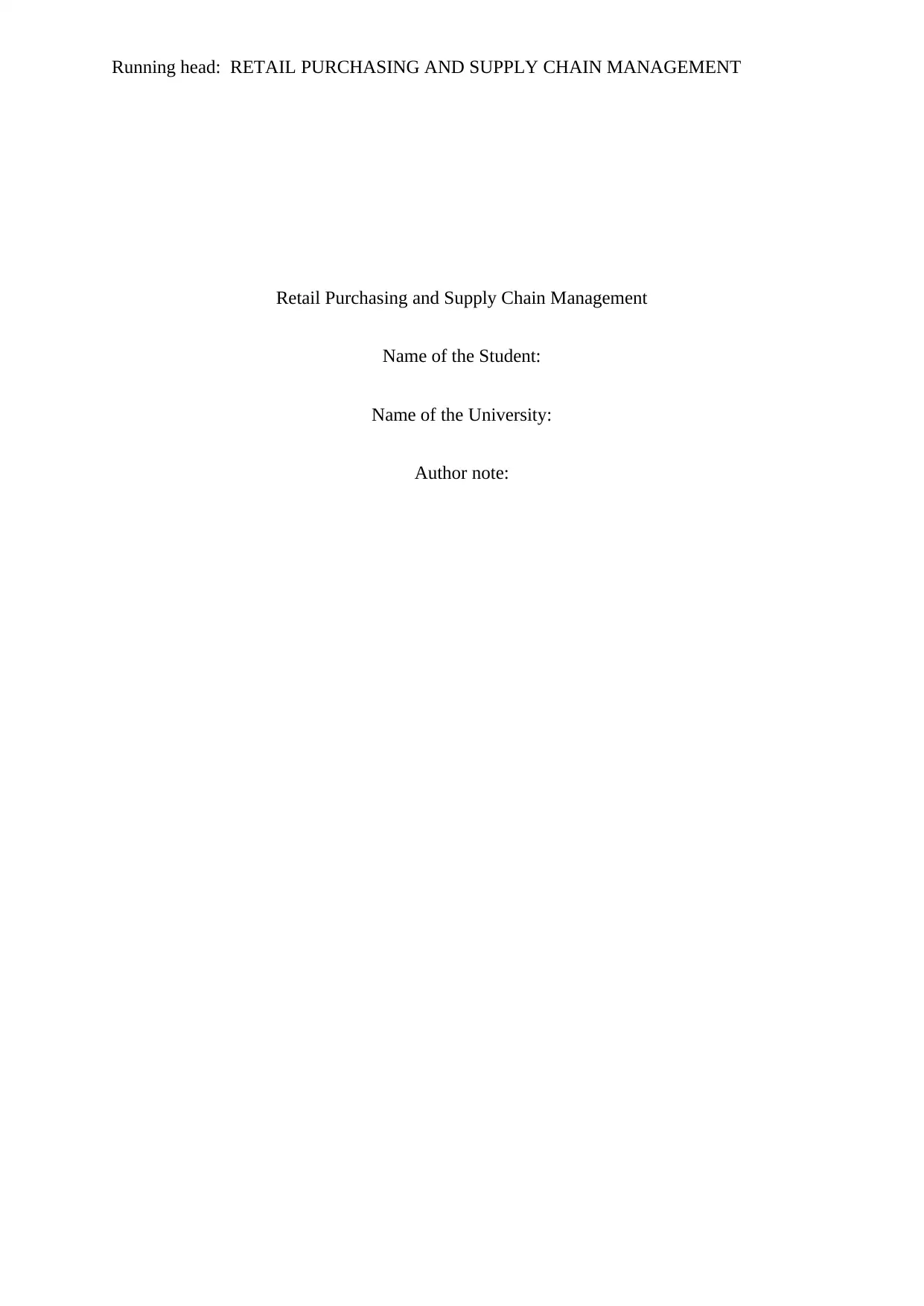
Running head: RETAIL PURCHASING AND SUPPLY CHAIN MANAGEMENT
Retail Purchasing and Supply Chain Management
Name of the Student:
Name of the University:
Author note:
Retail Purchasing and Supply Chain Management
Name of the Student:
Name of the University:
Author note:
Secure Best Marks with AI Grader
Need help grading? Try our AI Grader for instant feedback on your assignments.
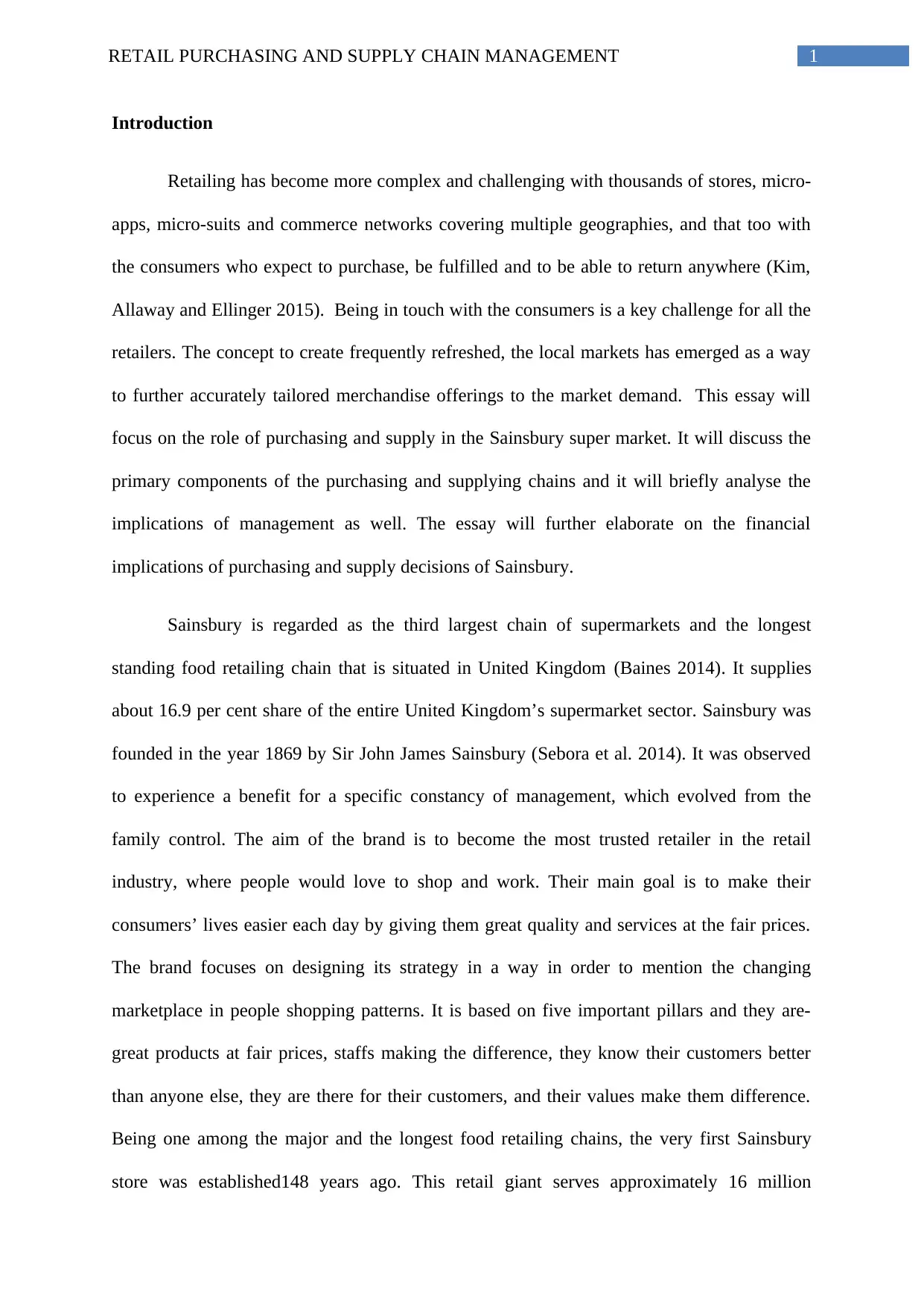
1RETAIL PURCHASING AND SUPPLY CHAIN MANAGEMENT
Introduction
Retailing has become more complex and challenging with thousands of stores, micro-
apps, micro-suits and commerce networks covering multiple geographies, and that too with
the consumers who expect to purchase, be fulfilled and to be able to return anywhere (Kim,
Allaway and Ellinger 2015). Being in touch with the consumers is a key challenge for all the
retailers. The concept to create frequently refreshed, the local markets has emerged as a way
to further accurately tailored merchandise offerings to the market demand. This essay will
focus on the role of purchasing and supply in the Sainsbury super market. It will discuss the
primary components of the purchasing and supplying chains and it will briefly analyse the
implications of management as well. The essay will further elaborate on the financial
implications of purchasing and supply decisions of Sainsbury.
Sainsbury is regarded as the third largest chain of supermarkets and the longest
standing food retailing chain that is situated in United Kingdom (Baines 2014). It supplies
about 16.9 per cent share of the entire United Kingdom’s supermarket sector. Sainsbury was
founded in the year 1869 by Sir John James Sainsbury (Sebora et al. 2014). It was observed
to experience a benefit for a specific constancy of management, which evolved from the
family control. The aim of the brand is to become the most trusted retailer in the retail
industry, where people would love to shop and work. Their main goal is to make their
consumers’ lives easier each day by giving them great quality and services at the fair prices.
The brand focuses on designing its strategy in a way in order to mention the changing
marketplace in people shopping patterns. It is based on five important pillars and they are-
great products at fair prices, staffs making the difference, they know their customers better
than anyone else, they are there for their customers, and their values make them difference.
Being one among the major and the longest food retailing chains, the very first Sainsbury
store was established148 years ago. This retail giant serves approximately 16 million
Introduction
Retailing has become more complex and challenging with thousands of stores, micro-
apps, micro-suits and commerce networks covering multiple geographies, and that too with
the consumers who expect to purchase, be fulfilled and to be able to return anywhere (Kim,
Allaway and Ellinger 2015). Being in touch with the consumers is a key challenge for all the
retailers. The concept to create frequently refreshed, the local markets has emerged as a way
to further accurately tailored merchandise offerings to the market demand. This essay will
focus on the role of purchasing and supply in the Sainsbury super market. It will discuss the
primary components of the purchasing and supplying chains and it will briefly analyse the
implications of management as well. The essay will further elaborate on the financial
implications of purchasing and supply decisions of Sainsbury.
Sainsbury is regarded as the third largest chain of supermarkets and the longest
standing food retailing chain that is situated in United Kingdom (Baines 2014). It supplies
about 16.9 per cent share of the entire United Kingdom’s supermarket sector. Sainsbury was
founded in the year 1869 by Sir John James Sainsbury (Sebora et al. 2014). It was observed
to experience a benefit for a specific constancy of management, which evolved from the
family control. The aim of the brand is to become the most trusted retailer in the retail
industry, where people would love to shop and work. Their main goal is to make their
consumers’ lives easier each day by giving them great quality and services at the fair prices.
The brand focuses on designing its strategy in a way in order to mention the changing
marketplace in people shopping patterns. It is based on five important pillars and they are-
great products at fair prices, staffs making the difference, they know their customers better
than anyone else, they are there for their customers, and their values make them difference.
Being one among the major and the longest food retailing chains, the very first Sainsbury
store was established148 years ago. This retail giant serves approximately 16 million
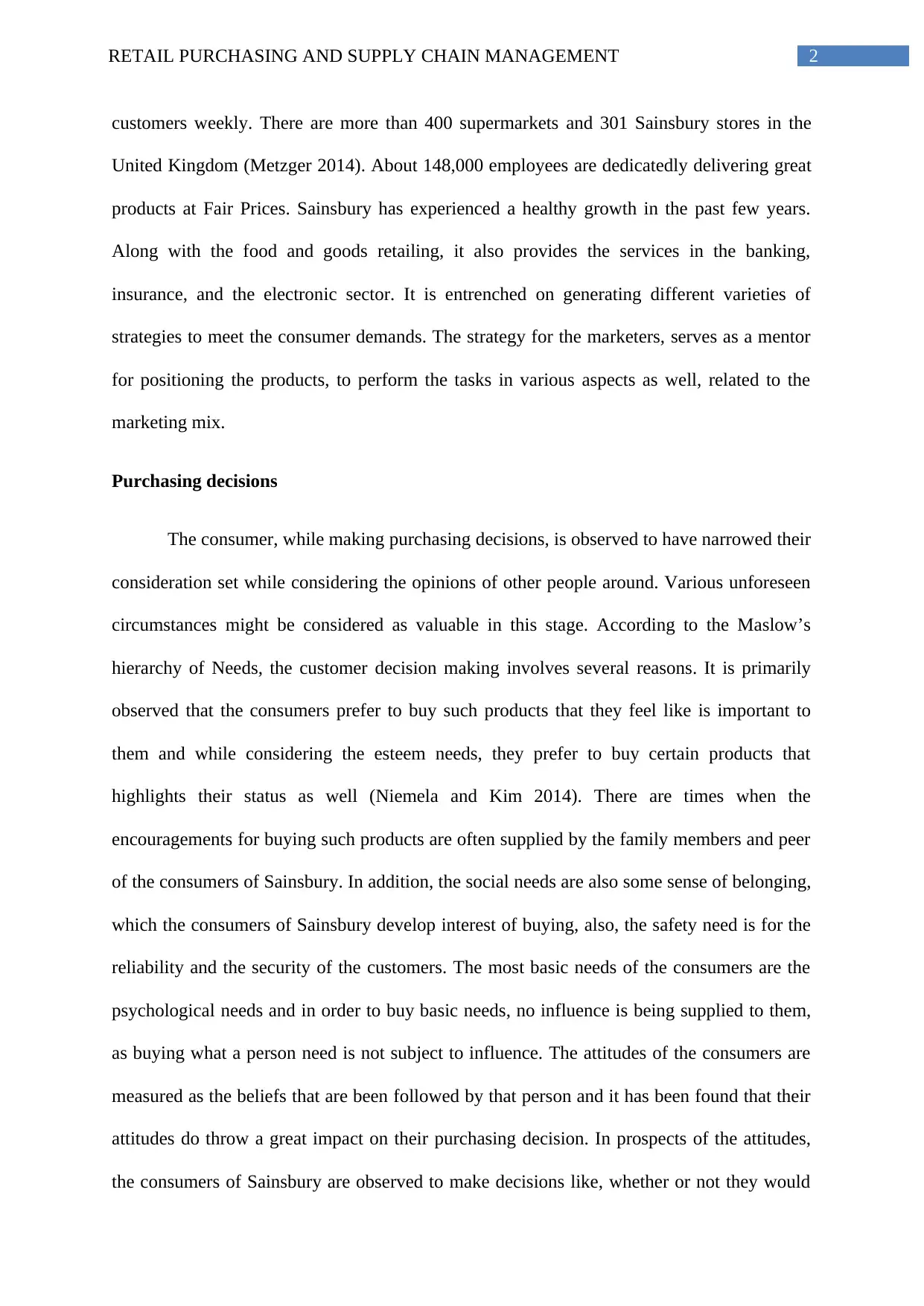
2RETAIL PURCHASING AND SUPPLY CHAIN MANAGEMENT
customers weekly. There are more than 400 supermarkets and 301 Sainsbury stores in the
United Kingdom (Metzger 2014). About 148,000 employees are dedicatedly delivering great
products at Fair Prices. Sainsbury has experienced a healthy growth in the past few years.
Along with the food and goods retailing, it also provides the services in the banking,
insurance, and the electronic sector. It is entrenched on generating different varieties of
strategies to meet the consumer demands. The strategy for the marketers, serves as a mentor
for positioning the products, to perform the tasks in various aspects as well, related to the
marketing mix.
Purchasing decisions
The consumer, while making purchasing decisions, is observed to have narrowed their
consideration set while considering the opinions of other people around. Various unforeseen
circumstances might be considered as valuable in this stage. According to the Maslow’s
hierarchy of Needs, the customer decision making involves several reasons. It is primarily
observed that the consumers prefer to buy such products that they feel like is important to
them and while considering the esteem needs, they prefer to buy certain products that
highlights their status as well (Niemela and Kim 2014). There are times when the
encouragements for buying such products are often supplied by the family members and peer
of the consumers of Sainsbury. In addition, the social needs are also some sense of belonging,
which the consumers of Sainsbury develop interest of buying, also, the safety need is for the
reliability and the security of the customers. The most basic needs of the consumers are the
psychological needs and in order to buy basic needs, no influence is being supplied to them,
as buying what a person need is not subject to influence. The attitudes of the consumers are
measured as the beliefs that are been followed by that person and it has been found that their
attitudes do throw a great impact on their purchasing decision. In prospects of the attitudes,
the consumers of Sainsbury are observed to make decisions like, whether or not they would
customers weekly. There are more than 400 supermarkets and 301 Sainsbury stores in the
United Kingdom (Metzger 2014). About 148,000 employees are dedicatedly delivering great
products at Fair Prices. Sainsbury has experienced a healthy growth in the past few years.
Along with the food and goods retailing, it also provides the services in the banking,
insurance, and the electronic sector. It is entrenched on generating different varieties of
strategies to meet the consumer demands. The strategy for the marketers, serves as a mentor
for positioning the products, to perform the tasks in various aspects as well, related to the
marketing mix.
Purchasing decisions
The consumer, while making purchasing decisions, is observed to have narrowed their
consideration set while considering the opinions of other people around. Various unforeseen
circumstances might be considered as valuable in this stage. According to the Maslow’s
hierarchy of Needs, the customer decision making involves several reasons. It is primarily
observed that the consumers prefer to buy such products that they feel like is important to
them and while considering the esteem needs, they prefer to buy certain products that
highlights their status as well (Niemela and Kim 2014). There are times when the
encouragements for buying such products are often supplied by the family members and peer
of the consumers of Sainsbury. In addition, the social needs are also some sense of belonging,
which the consumers of Sainsbury develop interest of buying, also, the safety need is for the
reliability and the security of the customers. The most basic needs of the consumers are the
psychological needs and in order to buy basic needs, no influence is being supplied to them,
as buying what a person need is not subject to influence. The attitudes of the consumers are
measured as the beliefs that are been followed by that person and it has been found that their
attitudes do throw a great impact on their purchasing decision. In prospects of the attitudes,
the consumers of Sainsbury are observed to make decisions like, whether or not they would
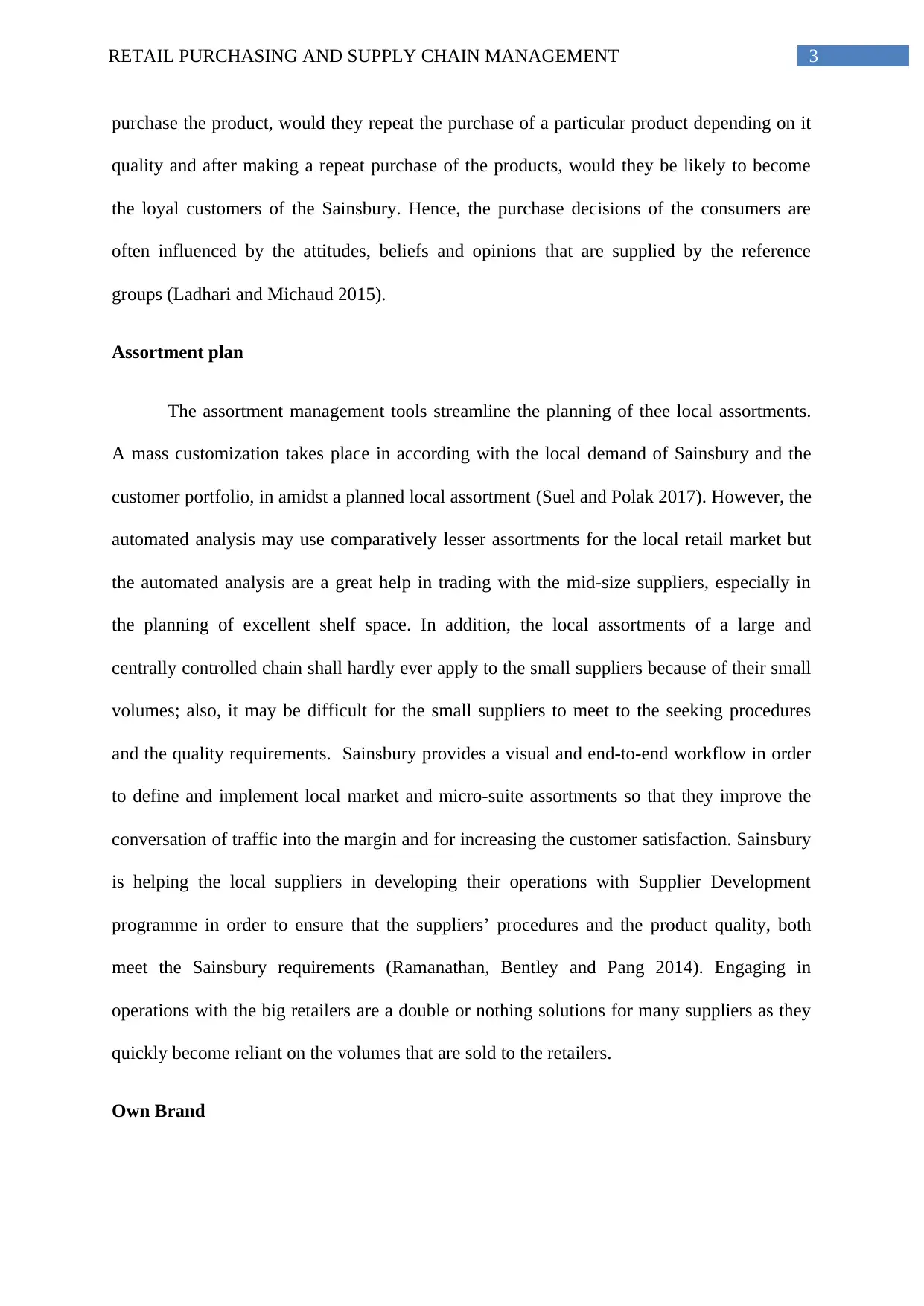
3RETAIL PURCHASING AND SUPPLY CHAIN MANAGEMENT
purchase the product, would they repeat the purchase of a particular product depending on it
quality and after making a repeat purchase of the products, would they be likely to become
the loyal customers of the Sainsbury. Hence, the purchase decisions of the consumers are
often influenced by the attitudes, beliefs and opinions that are supplied by the reference
groups (Ladhari and Michaud 2015).
Assortment plan
The assortment management tools streamline the planning of thee local assortments.
A mass customization takes place in according with the local demand of Sainsbury and the
customer portfolio, in amidst a planned local assortment (Suel and Polak 2017). However, the
automated analysis may use comparatively lesser assortments for the local retail market but
the automated analysis are a great help in trading with the mid-size suppliers, especially in
the planning of excellent shelf space. In addition, the local assortments of a large and
centrally controlled chain shall hardly ever apply to the small suppliers because of their small
volumes; also, it may be difficult for the small suppliers to meet to the seeking procedures
and the quality requirements. Sainsbury provides a visual and end-to-end workflow in order
to define and implement local market and micro-suite assortments so that they improve the
conversation of traffic into the margin and for increasing the customer satisfaction. Sainsbury
is helping the local suppliers in developing their operations with Supplier Development
programme in order to ensure that the suppliers’ procedures and the product quality, both
meet the Sainsbury requirements (Ramanathan, Bentley and Pang 2014). Engaging in
operations with the big retailers are a double or nothing solutions for many suppliers as they
quickly become reliant on the volumes that are sold to the retailers.
Own Brand
purchase the product, would they repeat the purchase of a particular product depending on it
quality and after making a repeat purchase of the products, would they be likely to become
the loyal customers of the Sainsbury. Hence, the purchase decisions of the consumers are
often influenced by the attitudes, beliefs and opinions that are supplied by the reference
groups (Ladhari and Michaud 2015).
Assortment plan
The assortment management tools streamline the planning of thee local assortments.
A mass customization takes place in according with the local demand of Sainsbury and the
customer portfolio, in amidst a planned local assortment (Suel and Polak 2017). However, the
automated analysis may use comparatively lesser assortments for the local retail market but
the automated analysis are a great help in trading with the mid-size suppliers, especially in
the planning of excellent shelf space. In addition, the local assortments of a large and
centrally controlled chain shall hardly ever apply to the small suppliers because of their small
volumes; also, it may be difficult for the small suppliers to meet to the seeking procedures
and the quality requirements. Sainsbury provides a visual and end-to-end workflow in order
to define and implement local market and micro-suite assortments so that they improve the
conversation of traffic into the margin and for increasing the customer satisfaction. Sainsbury
is helping the local suppliers in developing their operations with Supplier Development
programme in order to ensure that the suppliers’ procedures and the product quality, both
meet the Sainsbury requirements (Ramanathan, Bentley and Pang 2014). Engaging in
operations with the big retailers are a double or nothing solutions for many suppliers as they
quickly become reliant on the volumes that are sold to the retailers.
Own Brand
Paraphrase This Document
Need a fresh take? Get an instant paraphrase of this document with our AI Paraphraser
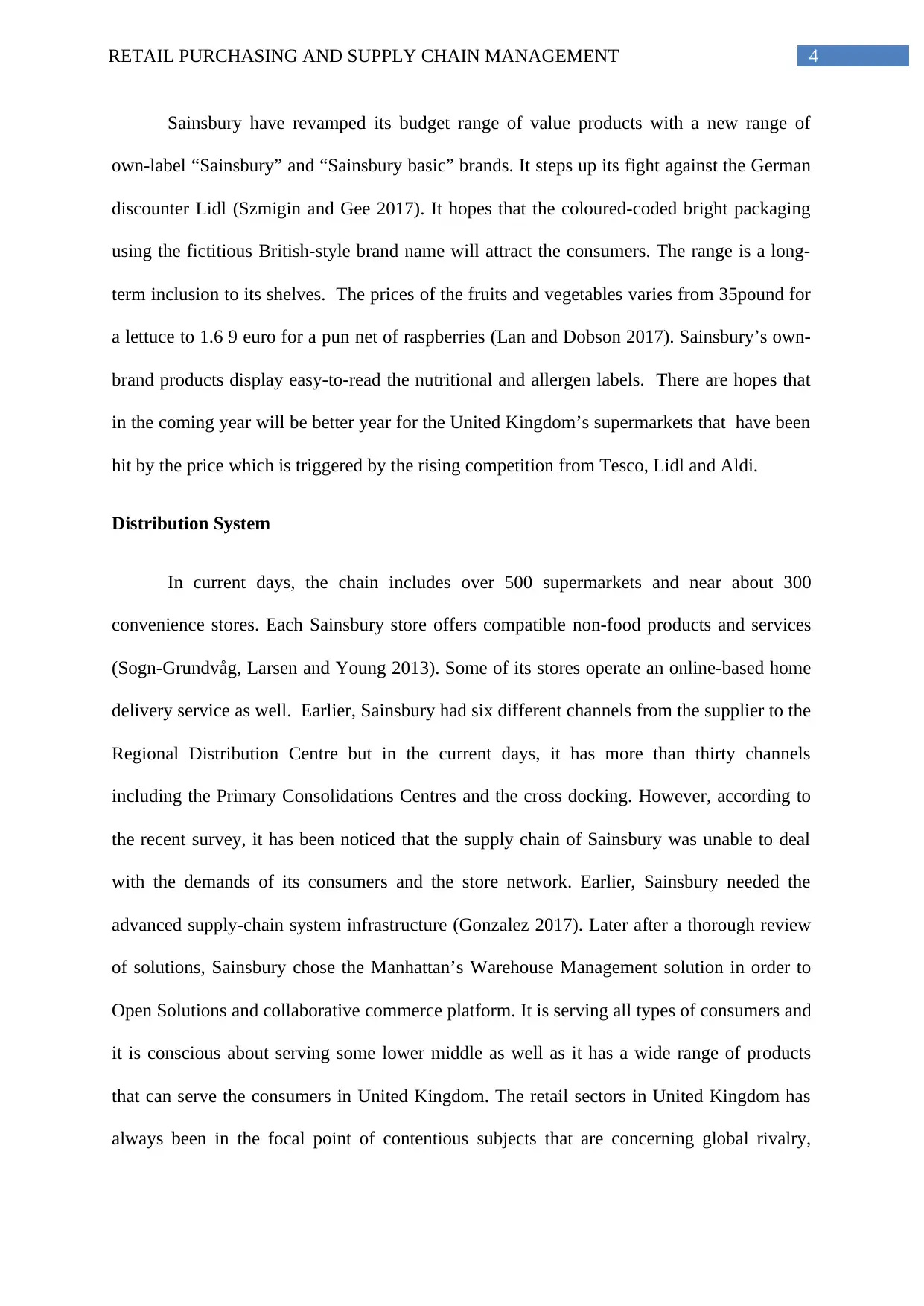
4RETAIL PURCHASING AND SUPPLY CHAIN MANAGEMENT
Sainsbury have revamped its budget range of value products with a new range of
own-label “Sainsbury” and “Sainsbury basic” brands. It steps up its fight against the German
discounter Lidl (Szmigin and Gee 2017). It hopes that the coloured-coded bright packaging
using the fictitious British-style brand name will attract the consumers. The range is a long-
term inclusion to its shelves. The prices of the fruits and vegetables varies from 35pound for
a lettuce to 1.6 9 euro for a pun net of raspberries (Lan and Dobson 2017). Sainsbury’s own-
brand products display easy-to-read the nutritional and allergen labels. There are hopes that
in the coming year will be better year for the United Kingdom’s supermarkets that have been
hit by the price which is triggered by the rising competition from Tesco, Lidl and Aldi.
Distribution System
In current days, the chain includes over 500 supermarkets and near about 300
convenience stores. Each Sainsbury store offers compatible non-food products and services
(Sogn-Grundvåg, Larsen and Young 2013). Some of its stores operate an online-based home
delivery service as well. Earlier, Sainsbury had six different channels from the supplier to the
Regional Distribution Centre but in the current days, it has more than thirty channels
including the Primary Consolidations Centres and the cross docking. However, according to
the recent survey, it has been noticed that the supply chain of Sainsbury was unable to deal
with the demands of its consumers and the store network. Earlier, Sainsbury needed the
advanced supply-chain system infrastructure (Gonzalez 2017). Later after a thorough review
of solutions, Sainsbury chose the Manhattan’s Warehouse Management solution in order to
Open Solutions and collaborative commerce platform. It is serving all types of consumers and
it is conscious about serving some lower middle as well as it has a wide range of products
that can serve the consumers in United Kingdom. The retail sectors in United Kingdom has
always been in the focal point of contentious subjects that are concerning global rivalry,
Sainsbury have revamped its budget range of value products with a new range of
own-label “Sainsbury” and “Sainsbury basic” brands. It steps up its fight against the German
discounter Lidl (Szmigin and Gee 2017). It hopes that the coloured-coded bright packaging
using the fictitious British-style brand name will attract the consumers. The range is a long-
term inclusion to its shelves. The prices of the fruits and vegetables varies from 35pound for
a lettuce to 1.6 9 euro for a pun net of raspberries (Lan and Dobson 2017). Sainsbury’s own-
brand products display easy-to-read the nutritional and allergen labels. There are hopes that
in the coming year will be better year for the United Kingdom’s supermarkets that have been
hit by the price which is triggered by the rising competition from Tesco, Lidl and Aldi.
Distribution System
In current days, the chain includes over 500 supermarkets and near about 300
convenience stores. Each Sainsbury store offers compatible non-food products and services
(Sogn-Grundvåg, Larsen and Young 2013). Some of its stores operate an online-based home
delivery service as well. Earlier, Sainsbury had six different channels from the supplier to the
Regional Distribution Centre but in the current days, it has more than thirty channels
including the Primary Consolidations Centres and the cross docking. However, according to
the recent survey, it has been noticed that the supply chain of Sainsbury was unable to deal
with the demands of its consumers and the store network. Earlier, Sainsbury needed the
advanced supply-chain system infrastructure (Gonzalez 2017). Later after a thorough review
of solutions, Sainsbury chose the Manhattan’s Warehouse Management solution in order to
Open Solutions and collaborative commerce platform. It is serving all types of consumers and
it is conscious about serving some lower middle as well as it has a wide range of products
that can serve the consumers in United Kingdom. The retail sectors in United Kingdom has
always been in the focal point of contentious subjects that are concerning global rivalry,

5RETAIL PURCHASING AND SUPPLY CHAIN MANAGEMENT
corporation presentation, price wars and the alterations in plan and they are effectively
serving within a large range.
Inventory Management
The nature of the operations in Sainsbury has been so distinct that each department of
the store has its own operation in order to make sure that there is a security of supplies and a
more safer mount in the inventory management without undermine anything in cost. The
Kraljic procurement matrix has helped the Sainsbury’s process of procurement become a
strategic one. The primary factor that involves in the process of ensuring the classification of
the purchase is indexing the purchases depending on supply risk and the impact of profit on a
product. The second factor is concerned about the analysis of market and the third step
includes strategic positioning. It is all about ensuring that the highest profit impact items are
purchased, while currently reducing the high risk of ineventory supply excess or shortage.
The various aspects of Kraljic matrix consisting successful influence of the supply deals
depends on the enlarging buyer power, supply continuity, effective cooperation, and the
efficient usage of the resources are important in examining the Sainsbury’s operations, also, it
will be engaged throughout this essay (Mantere 2015). New technology has been
implemented in order to ensure that the best of it is utilised. Wide ranges of new and advance
systems are implemented in the areas like trade, finance, human resource and in the
procurement among others as well. It has been supported by applying latest hardware and
software system by the IT department of Sainsbury.
Customer Service
“Excellence” has always remained a very significant word in customer care
(Christopher 2016). When adding terms like “customer” and “service” to excellence, the
resulted phrase ends up in a company striving and being creative and passionate in their
corporation presentation, price wars and the alterations in plan and they are effectively
serving within a large range.
Inventory Management
The nature of the operations in Sainsbury has been so distinct that each department of
the store has its own operation in order to make sure that there is a security of supplies and a
more safer mount in the inventory management without undermine anything in cost. The
Kraljic procurement matrix has helped the Sainsbury’s process of procurement become a
strategic one. The primary factor that involves in the process of ensuring the classification of
the purchase is indexing the purchases depending on supply risk and the impact of profit on a
product. The second factor is concerned about the analysis of market and the third step
includes strategic positioning. It is all about ensuring that the highest profit impact items are
purchased, while currently reducing the high risk of ineventory supply excess or shortage.
The various aspects of Kraljic matrix consisting successful influence of the supply deals
depends on the enlarging buyer power, supply continuity, effective cooperation, and the
efficient usage of the resources are important in examining the Sainsbury’s operations, also, it
will be engaged throughout this essay (Mantere 2015). New technology has been
implemented in order to ensure that the best of it is utilised. Wide ranges of new and advance
systems are implemented in the areas like trade, finance, human resource and in the
procurement among others as well. It has been supported by applying latest hardware and
software system by the IT department of Sainsbury.
Customer Service
“Excellence” has always remained a very significant word in customer care
(Christopher 2016). When adding terms like “customer” and “service” to excellence, the
resulted phrase ends up in a company striving and being creative and passionate in their

6RETAIL PURCHASING AND SUPPLY CHAIN MANAGEMENT
attempt to satisfy their consumer in a great manner. There is a varied range of products or
items that is offered and sold in the Sainsbury super market. It starts from offering clothing,
gift items, computer peripherals, books, kitchen appliances, food products, groceries and
many more. The main aim of this super market is to gratify its customer by providing them
great shopping experiences. They also take into account the Excellency and quality of
products at a very fair price (Faulkner et al. 2014). However, the prices may differ on a daily
basis as well. They furnish their customer with safe, fresh, tasty and healthy food at a price
that is reasonable and ensures an excellent consumer service (Scarborough et al. 2015). The
customers are greeted with a friendly smile and pleasant word while entering into the market.
The customers can purchase a ‘fits all’ trolley for shopping in the Sainsbury supermarket
worth £1 at the Sainsbury customer service desk. The store gives loyalty points as well for
using their bags. The customer service desk provides the customers with in-store nutrition
and dietary advice; also, their online website provides them with online nutrition advice
services. Each store in the Sainsbury supermarket accepts cash, credit cards and debit cards,
which makes convenient for the consumers to make purchasing. The large range of products
along with the ever-growing range of fair-trade and organic products and the free from
products are of major advantage to the Sainsbury consumers. They also have the availability
of only shopping site so that their customer can experience convenient shopping. However,
the disadvantages for the Sainsbury consumers are that the prices can alter on a daily basis
and varies from store to store. In addition to this, the online buyers pay their delivery day’s
price only (which changes daily).
Conclusion
Behind every large company to the minor stores, there is to be a good system that
makes it run. It can be concluded from the above analysis that purchasing and supply in
Sainsbury plays a very important role in its business management. Sainsbury has a huge
attempt to satisfy their consumer in a great manner. There is a varied range of products or
items that is offered and sold in the Sainsbury super market. It starts from offering clothing,
gift items, computer peripherals, books, kitchen appliances, food products, groceries and
many more. The main aim of this super market is to gratify its customer by providing them
great shopping experiences. They also take into account the Excellency and quality of
products at a very fair price (Faulkner et al. 2014). However, the prices may differ on a daily
basis as well. They furnish their customer with safe, fresh, tasty and healthy food at a price
that is reasonable and ensures an excellent consumer service (Scarborough et al. 2015). The
customers are greeted with a friendly smile and pleasant word while entering into the market.
The customers can purchase a ‘fits all’ trolley for shopping in the Sainsbury supermarket
worth £1 at the Sainsbury customer service desk. The store gives loyalty points as well for
using their bags. The customer service desk provides the customers with in-store nutrition
and dietary advice; also, their online website provides them with online nutrition advice
services. Each store in the Sainsbury supermarket accepts cash, credit cards and debit cards,
which makes convenient for the consumers to make purchasing. The large range of products
along with the ever-growing range of fair-trade and organic products and the free from
products are of major advantage to the Sainsbury consumers. They also have the availability
of only shopping site so that their customer can experience convenient shopping. However,
the disadvantages for the Sainsbury consumers are that the prices can alter on a daily basis
and varies from store to store. In addition to this, the online buyers pay their delivery day’s
price only (which changes daily).
Conclusion
Behind every large company to the minor stores, there is to be a good system that
makes it run. It can be concluded from the above analysis that purchasing and supply in
Sainsbury plays a very important role in its business management. Sainsbury has a huge
Secure Best Marks with AI Grader
Need help grading? Try our AI Grader for instant feedback on your assignments.
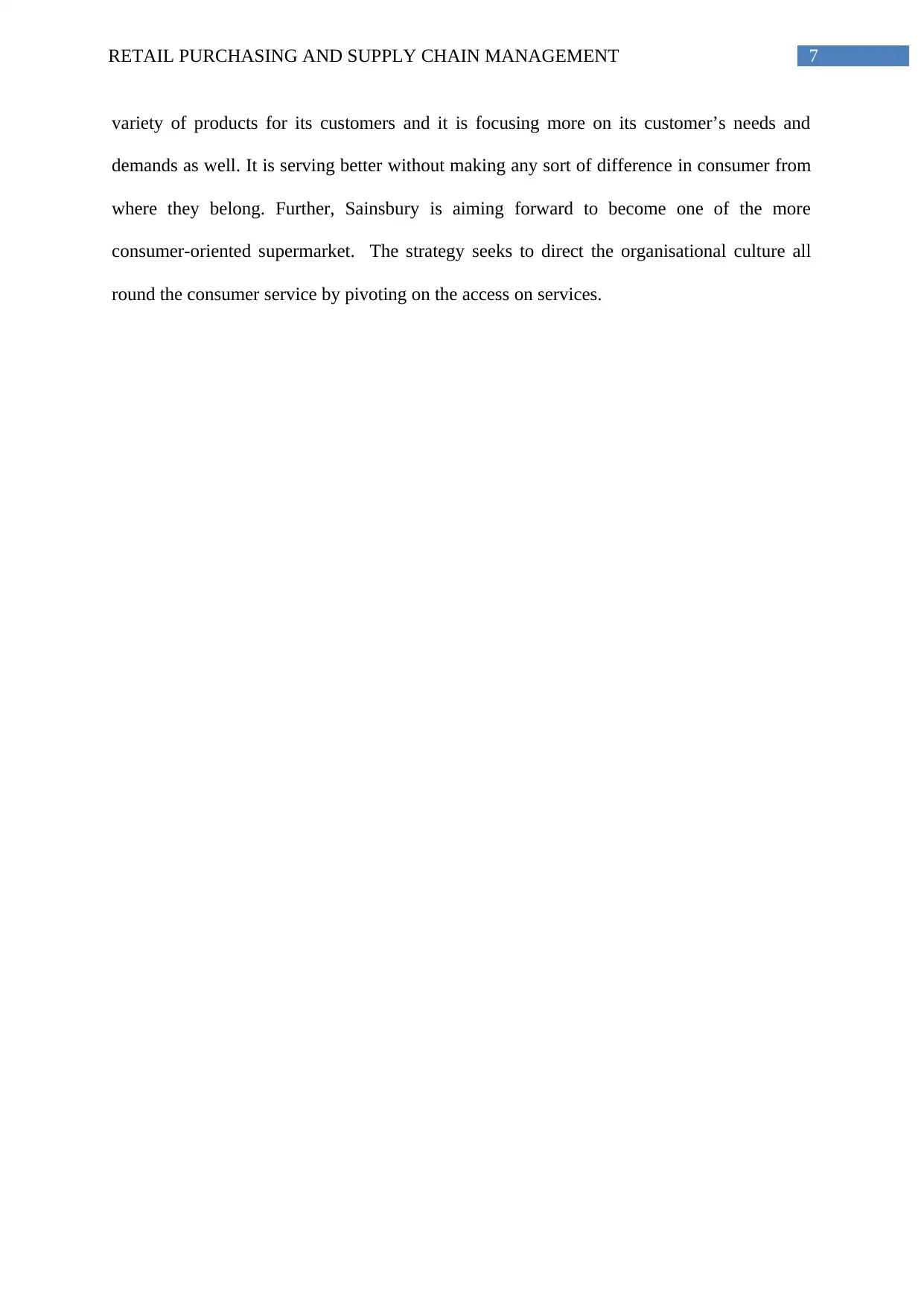
7RETAIL PURCHASING AND SUPPLY CHAIN MANAGEMENT
variety of products for its customers and it is focusing more on its customer’s needs and
demands as well. It is serving better without making any sort of difference in consumer from
where they belong. Further, Sainsbury is aiming forward to become one of the more
consumer-oriented supermarket. The strategy seeks to direct the organisational culture all
round the consumer service by pivoting on the access on services.
variety of products for its customers and it is focusing more on its customer’s needs and
demands as well. It is serving better without making any sort of difference in consumer from
where they belong. Further, Sainsbury is aiming forward to become one of the more
consumer-oriented supermarket. The strategy seeks to direct the organisational culture all
round the consumer service by pivoting on the access on services.

8RETAIL PURCHASING AND SUPPLY CHAIN MANAGEMENT
References-
Baines, J., 2014. Food price inflation as redistribution: towards a new analysis of corporate
power in the world food system. New Political Economy, 19(1), pp.79-112.
Christopher, M., 2016. Logistics & supply chain management. Pearson UK.
Faulkner, G.P., Livingstone, M.B.E., McCaffrey, T.A. and Kerr, M.A., 2014. Supermarket
own brand foods: lower in energy cost but similar in nutritional quality to their market brand
alternatives. Journal of human nutrition and dietetics, 27(6), pp.617-625.
González, X., 2017. Chain heterogeneity and price-setting behavior: Evidence from e-grocery
retailers. Electronic Commerce Research and Applications.
Kim, K., Allaway, A.W. and Ellinger, A.E., 2015. Retail Assortment Size and Customer
Choice Overload: The Influence of Shopping Enjoyment and Time Pressure. In Marketing
Dynamism & Sustainability: Things Change, Things Stay the Same… (pp. 139-139).
Springer, Cham.
Ladhari, R. and Michaud, M., 2015. eWOM effects on hotel booking intentions, attitudes,
trust, and website perceptions. International Journal of Hospitality Management, 46, pp.36-
45.
Lan, H. and Dobson, P.W., 2017. Healthy Competition to Support Healthy Eating? An
Investigation of Fruit and Vegetable Pricing in UK Supermarkets. Journal of Agricultural
Economics, 68(3), pp.881-900.
Mantere, A., 2015. Management of a supplier collaboration-The usage of control and
coordination mechanisms.
Metzger, K., 2014. Business analysis of UK supermarket industry.
References-
Baines, J., 2014. Food price inflation as redistribution: towards a new analysis of corporate
power in the world food system. New Political Economy, 19(1), pp.79-112.
Christopher, M., 2016. Logistics & supply chain management. Pearson UK.
Faulkner, G.P., Livingstone, M.B.E., McCaffrey, T.A. and Kerr, M.A., 2014. Supermarket
own brand foods: lower in energy cost but similar in nutritional quality to their market brand
alternatives. Journal of human nutrition and dietetics, 27(6), pp.617-625.
González, X., 2017. Chain heterogeneity and price-setting behavior: Evidence from e-grocery
retailers. Electronic Commerce Research and Applications.
Kim, K., Allaway, A.W. and Ellinger, A.E., 2015. Retail Assortment Size and Customer
Choice Overload: The Influence of Shopping Enjoyment and Time Pressure. In Marketing
Dynamism & Sustainability: Things Change, Things Stay the Same… (pp. 139-139).
Springer, Cham.
Ladhari, R. and Michaud, M., 2015. eWOM effects on hotel booking intentions, attitudes,
trust, and website perceptions. International Journal of Hospitality Management, 46, pp.36-
45.
Lan, H. and Dobson, P.W., 2017. Healthy Competition to Support Healthy Eating? An
Investigation of Fruit and Vegetable Pricing in UK Supermarkets. Journal of Agricultural
Economics, 68(3), pp.881-900.
Mantere, A., 2015. Management of a supplier collaboration-The usage of control and
coordination mechanisms.
Metzger, K., 2014. Business analysis of UK supermarket industry.
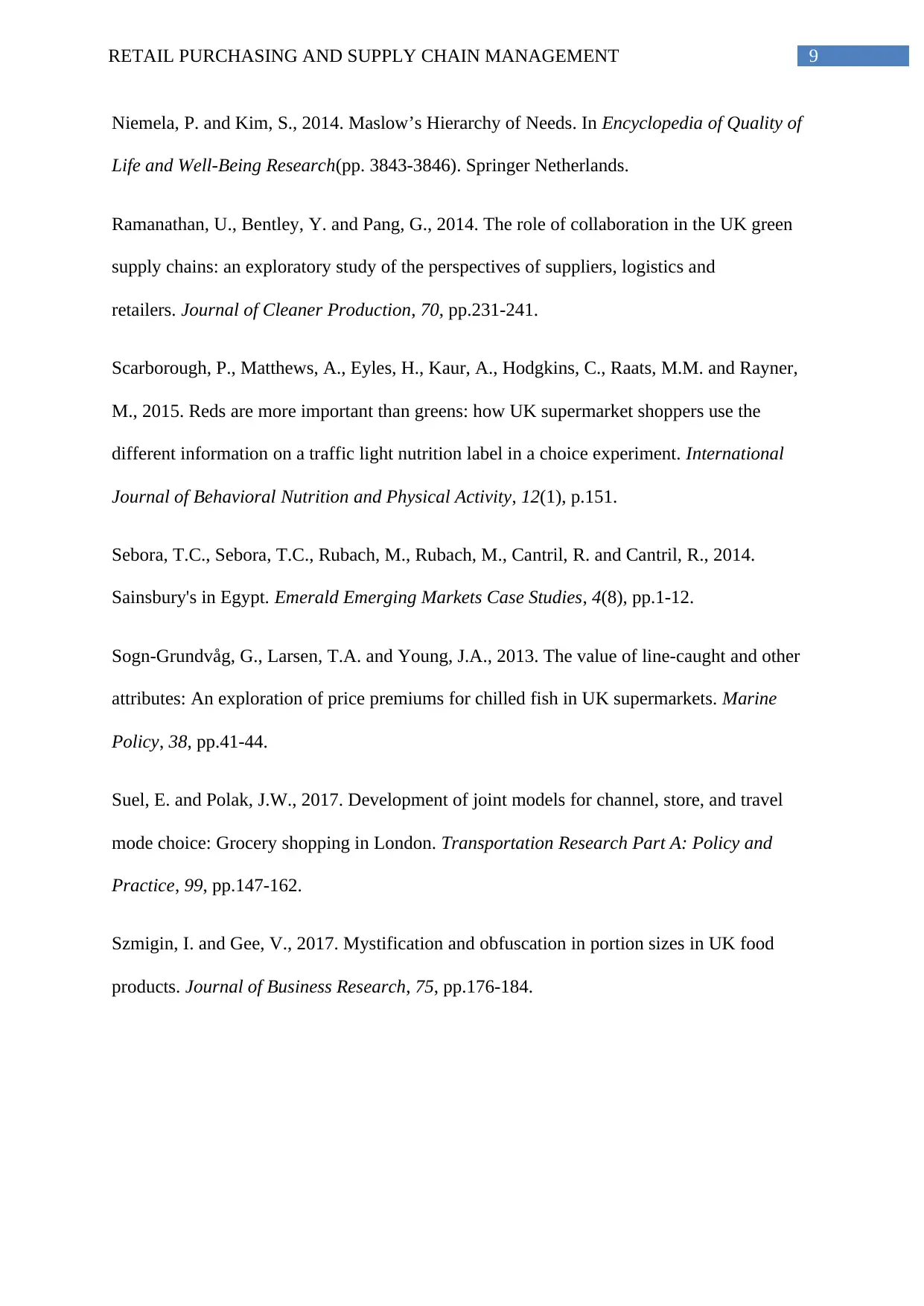
9RETAIL PURCHASING AND SUPPLY CHAIN MANAGEMENT
Niemela, P. and Kim, S., 2014. Maslow’s Hierarchy of Needs. In Encyclopedia of Quality of
Life and Well-Being Research(pp. 3843-3846). Springer Netherlands.
Ramanathan, U., Bentley, Y. and Pang, G., 2014. The role of collaboration in the UK green
supply chains: an exploratory study of the perspectives of suppliers, logistics and
retailers. Journal of Cleaner Production, 70, pp.231-241.
Scarborough, P., Matthews, A., Eyles, H., Kaur, A., Hodgkins, C., Raats, M.M. and Rayner,
M., 2015. Reds are more important than greens: how UK supermarket shoppers use the
different information on a traffic light nutrition label in a choice experiment. International
Journal of Behavioral Nutrition and Physical Activity, 12(1), p.151.
Sebora, T.C., Sebora, T.C., Rubach, M., Rubach, M., Cantril, R. and Cantril, R., 2014.
Sainsbury's in Egypt. Emerald Emerging Markets Case Studies, 4(8), pp.1-12.
Sogn-Grundvåg, G., Larsen, T.A. and Young, J.A., 2013. The value of line-caught and other
attributes: An exploration of price premiums for chilled fish in UK supermarkets. Marine
Policy, 38, pp.41-44.
Suel, E. and Polak, J.W., 2017. Development of joint models for channel, store, and travel
mode choice: Grocery shopping in London. Transportation Research Part A: Policy and
Practice, 99, pp.147-162.
Szmigin, I. and Gee, V., 2017. Mystification and obfuscation in portion sizes in UK food
products. Journal of Business Research, 75, pp.176-184.
Niemela, P. and Kim, S., 2014. Maslow’s Hierarchy of Needs. In Encyclopedia of Quality of
Life and Well-Being Research(pp. 3843-3846). Springer Netherlands.
Ramanathan, U., Bentley, Y. and Pang, G., 2014. The role of collaboration in the UK green
supply chains: an exploratory study of the perspectives of suppliers, logistics and
retailers. Journal of Cleaner Production, 70, pp.231-241.
Scarborough, P., Matthews, A., Eyles, H., Kaur, A., Hodgkins, C., Raats, M.M. and Rayner,
M., 2015. Reds are more important than greens: how UK supermarket shoppers use the
different information on a traffic light nutrition label in a choice experiment. International
Journal of Behavioral Nutrition and Physical Activity, 12(1), p.151.
Sebora, T.C., Sebora, T.C., Rubach, M., Rubach, M., Cantril, R. and Cantril, R., 2014.
Sainsbury's in Egypt. Emerald Emerging Markets Case Studies, 4(8), pp.1-12.
Sogn-Grundvåg, G., Larsen, T.A. and Young, J.A., 2013. The value of line-caught and other
attributes: An exploration of price premiums for chilled fish in UK supermarkets. Marine
Policy, 38, pp.41-44.
Suel, E. and Polak, J.W., 2017. Development of joint models for channel, store, and travel
mode choice: Grocery shopping in London. Transportation Research Part A: Policy and
Practice, 99, pp.147-162.
Szmigin, I. and Gee, V., 2017. Mystification and obfuscation in portion sizes in UK food
products. Journal of Business Research, 75, pp.176-184.
1 out of 10
![[object Object]](/_next/static/media/star-bottom.7253800d.svg)





